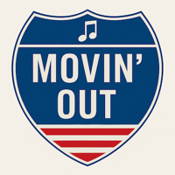
Overview
Synopsis
In Movin’ Out, a group of close friends from Long Island navigate the 1960s and 1970s. High school sweethearts Brenda and Eddie break up, while their classmates James and Judy plan to marry. Their friend Tony longs for the same kind of connection and falls for Brenda after she becomes more independent. Their carefree youth is abruptly interrupted when Eddie, James, and Tony are sent to fight in Vietnam, leaving Brenda and Judy at home. The war leaves lasting scars: James is killed, and Eddie and Tony return home deeply changed.
Act II follows their attempts to rebuild their lives. Eddie spirals into addiction and is haunted by traumatic memories, while Tony struggles to reconnect with Brenda. A chance encounter between Eddie and Judy helps him find forgiveness and begin healing. Eventually, Brenda and Tony rekindle their relationship, and the surviving friends come back together, acknowledging their losses while looking toward a hopeful future. The story is told entirely through Billy Joel’s songs and Twyla Tharp’s choreography rather than spoken dialogue.
Show Information
Context
Movin’ Out is a jukebox dance musical conceived by Twyla Tharp, built entirely around the music of Billy Joel. Premiering on Broadway in 2002, the show broke from the traditional book-musical format by using Joel’s songs as a narrative score rather than dialogue-driven storytelling. Instead of spoken scenes, the production relies on interpretive dance and movement to tell the story of a group of friends growing up in suburban America during the turbulence of the 1960s and 1970s. The unique
to read the context for Movin' Out and to unlock other amazing theatre resources!Plot
Characters
| Name | Part Size | Gender | Vocal Part |
|---|---|---|---|
|
Lead |
Male |
Non-singer |
|
|
Lead |
Male |
Non-singer |
|
|
Lead |
Male |
Non-singer |
|
|
Lead |
Female |
Non-singer |
|
|
Lead |
Female |
Non-singer |
|
|
Lead |
Male |
Tenor, Baritone |
|
|
Supporting |
Not Specified |
|
|
|
Featured |
Male |
Non-singer |
|
|
Ensemble |
Not Specified |
Non-singer |
Songs
Act I
Notes
Note: Movin’ Out has never been released for general licensing. The following song list reflects the Broadway and touring productions, which remain the only versions performed professionally.
Act II
A song with an asterisk (*) before the title indicates a dance number.
Monologues
Scenes
Key Terms
A concept musical is a type of musical structured around a central idea, theme, or message rather than a straightforward linear plot. Songs, characters, and scenes are often arranged to explore this unifying concept from different perspectives. This style allows for greater experimentation and can blend satire, social commentary, or abstract storytelling.
A dance narrative is a form of storytelling that relies on movement rather than spoken dialogue or written text. Choreography conveys character, emotion, and plot, allowing audiences to understand the story through physical expression. This technique is common in dance-focused theatre, ballets, and movement-based productions.
A jukebox musical is a type of musical where the score is made up of pre-existing, well-known popular songs instead of original music.
Non-verbal theatre communicates ideas, emotions, and stories without the use of spoken words. It often relies on movement, music, mime, or visual imagery to engage the audience. This form emphasizes universal human expression and can transcend language barriers.
A rock musical is a form of musical theatre that incorporates the rhythms, instrumentation, and energy of rock-and-roll into its score. Emerging in the late 1960s with shows like Hair, rock musicals often bring a contemporary, rebellious edge to the stage. They blend theatrical storytelling with the raw power of popular music to attract younger and more diverse audiences.
Videos
Quizzes
Sorry! We do not currently have quizzes for this guide.
Themes, Symbols & Motifs
Themes
Friendship and Loyalty – At its heart, the
to read about the themes, symbols and motifs from Movin' Out and to unlock other amazing theatre resources!Quote Analysis
Sorry! We do not currently have learning modules for this guide.